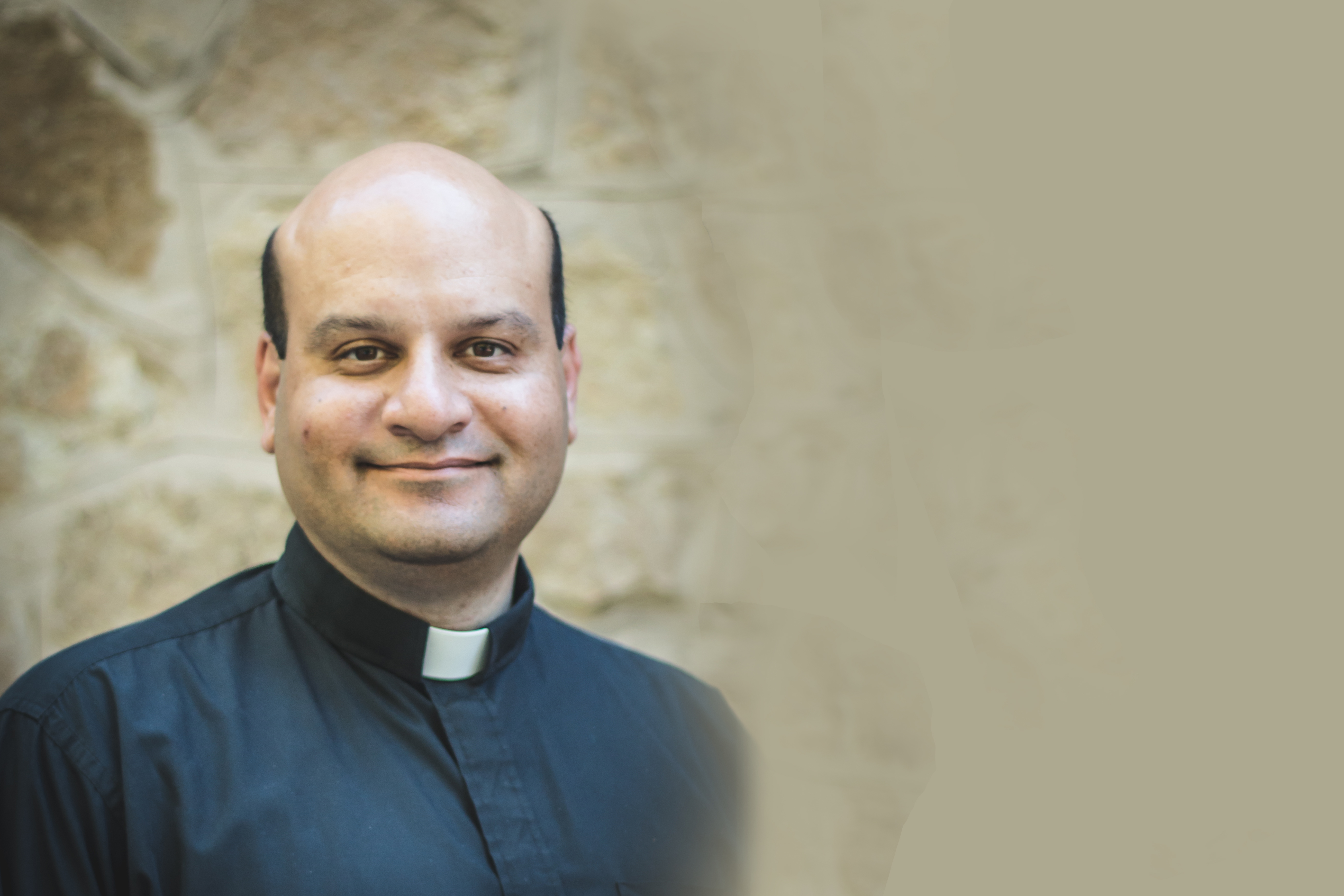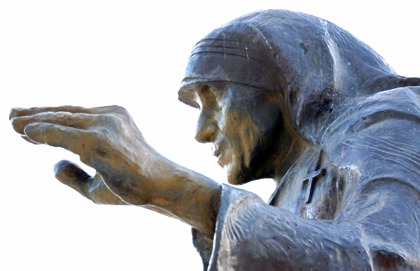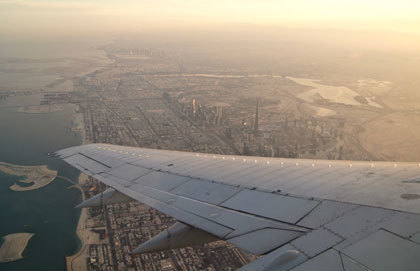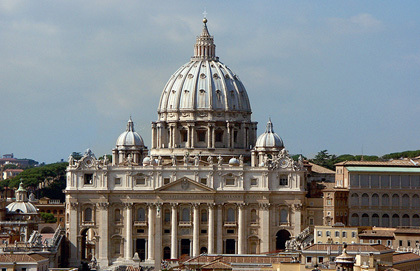A hasty solution was adopted, with Pope Francis adding an unscheduled visit to venerate the relics of two recently beatified Polish missionaries, Franciscan friars killed by the Marxist Shining Path guerrillas in 1991 in Peru. There the Holy Father offered a prayer for deliverance from the “devastating wave of terrorism” without further specification. There was, though, a hint of where the Holy Father was heading in a part of the prayer for the “families of the victims of terrorism,” asking that they might find the “courage to continue to be brothers and sisters for others, above all for immigrants.” The pivot from terror to immigration indicated the Holy Father’s frustration that the summer of Islamist terrorism is dampening popular enthusiasm for greater settlement of Muslim refugees in Europe.
Finally, on the flight home, Pope Francis made clear his current thinking that there is no such phenomenon as Islamist violence, any more than domestic violence in Italy constitutes “Catholic violence.” Going further still, he acknowledged that “there are violent persons of [Islam]… this is true: I believe that in pretty much every religion there is always a small group of fundamentalists. Fundamentalists. We have them.”
It was not clear whether Pope Francis was speaking historically or contemporaneously, but if the latter, there is no evidence of violent Catholic fundamentalists at work anywhere in the world today. That the head of the Catholic Church would suggest such is simply remarkable. Remarkable, too, was that the remarks, while covered in the Catholic press, were relegated to secondary coverage in the secular press. Perhaps the novelty of the Holy Father’s in-flight press conferences is wearing off. Which may be for the best.
King Jan III Sobieski: 1683 and All That
I have visited the cathedral of Kraków – the repository of Polish culture and memory – many times. Pope Francis is a pastor of powerful gestures, but he missed an opportunity for one when he went to pray there. He should have made a prolonged, prayerful and purposeful visit to the tombs in Wawel Cathedral, first among them that of King Jan III Sobieski.
There is no figure in European history more associated with righteous resistance to aggressive Islamic expansion than the 17th century king of Poland who defeated the Turks at the Battle of Vienna in 1683. Upon victory, Sobieski was hailed as the saviour of Christendom, but he deflected the honour, expressing himself in lapidary Latin: Veni, vidi, Deus vincit! (I came, I saw, God conquered!)
Pope Francis need not have said anything. But to visit the tomb of the historic hero of resistance to aggressive Islam would have spoken volumes. Sobieski is buried, alongside other heroes of Polish history, in the crypt of Wawel Cathedral. Indeed, his sarcophagus is in St. Leonard’s Chapel, in the place of honour across from the altar, where a newly ordained Father Karol Wojty?a chose to offer his first Holy Mass on All Souls Day, 1946. Pope Francis, coming to Kraków in part to honour the great Pope of Mercy, could have venerated the altar of Saint John Paul II’s first Mass before visiting Sobieski’s tomb, where he might have offered a silent prayer that something akin to the spirit of 1683 might reawaken in Europe.
It would have been salutary for WYD pilgrims, to say nothing of the world press, to consider why John Paul II chose Saint Leonard’s crypt, in the presence of King Jan III Sobieski’s remains, for his first Mass. Indeed, all of Wawel Cathedral is an instructive lesson as the world faces new threats to liberty.
Karol Wojty?a went to Wawel for his first Mass because he was both a Christian disciple and a Polish patriot, and he considered Polish history to be a drama of fidelity amid difficult trials. There is no place where Polish history is more tangible than in Kraków, the ancient and royal capital of the Polish nation. The heart of Kraków is Wawel Hill, the site of the royal palace and the cathedral. The crypt of the cathedral, repository of the royal sarcophagi and resting place of the heroes of Polish history, is a place of national memory.
On the main altar upstairs are the remains of St. Stanis?aw, the bishop of Kraków martyred in 1079 by King Boles?aw himself while he was celebrating Holy Mass.
After President Lech Kaczy?ski of Poland was killed in an April 2010 plane crash, his remains were brought back to Poland to lie in state in the Belvedere Palace in Warsaw, and then to be laid to rest, along with his wife, Maria, who died in the same accident, in the crypt of Wawel Cathedral.
Kaczy?ski’s plane crashed as he was on his way to commemorate the 70th th anniversary of the 1940 Katyn massacre, when the Soviet secret police killed more than 20,000 Polish military personnel (half of the entire officer corps) along with other social and cultural leaders. It was the definitive Soviet contribution to the dismemberment of Poland in alliance with the Nazis. Poland had already been defeated in 1939; the 1940 Katyn killings murders were an attempt to mortally wound the hope that an independent Poland would return.
The Kaczy?ski grave is intended to be a broader memorial to those killed at Katyn, to register in the royal crypt, as it were, the memory of those who died at the hands of the invaders who were attempting to kill Poland. Had the Pope paused at that plaque commemorating the Katyn massacre near the Kaczy?ski grave, it would have been a powerful signal to the current tyrant in Moscow that the Church has not forgotten his invasion of Ukraine, even if the world is eager to move on.
To visit the tombs of Kraków is to realize how often Poland has been on the front lines protecting Europe’s liberty. Not far from Kaczy?ski’s tomb is that of Józef Pi?sudski, Poland’s chief of state when it returned to the map of Europe in 1918 after more than a century of partition. War soon came with the Russian Bolshevik regime, and the fighting reached Warsaw itself until Pi?sudski’s forces prevailed in a battle often called the “miracle at the Vistula River.” Had Poland not prevailed in 1920, Russian communism would have spread to the heart of Europe in the aftermath of the First World War, with dire consequences for the reconstruction of a free Europe.
Poland in 1683, in 1920 and then again in 1989 was in the vanguard of making Europe safe for free and independent countries. During WYD, the liberation of Europe from Soviet tyranny in 1989 was often mentioned, giving due honour to John Paul II. The saint himself chose to honour Polish history, and King Jan III Sobieski, at his first Mass. It was a missed opportunity to remember the great Polish king for the pilgrims in Kraków, the heart of Poland, and in important ways, the heart of Europe, which is now bleeding.
Forgetting Regensburg
It’s been 15 years since 9/11. Catholic responses to jihadist violence have been varied since but are growing more divergent today. Pope Francis over the summer staked out the most extreme position of any world leader on the issue of Islamist violence, rejecting the approach taken by Pope Benedict XVI and putting him at odds with leading Catholic bishops in the Middle East. That dramatic divergence was highlighted in Toronto in August at the Knights of Columbus convention, which drew attention to the persecution of Christians.
Ten years ago, on September 12, 2006, Pope Benedict delivered one of the most important speeches of the 21st century at Regensburg. Speaking about the relationship of faith and reason, the Holy Father took up the question of religious violence. He proposed that it raised a theological question about the nature of God. Was God’s sovereignty beyond all human categories of reason and therefore capable of commanding anything? Or was God Himself reasonable, so that to act against reason was to act against God’s will? If the latter was true – that God could not act contrary to reason – then it was contrary to God’s will to coerce faith by violence. Faith by its very nature must be a free act, therefore violence in the name of faith was contrary to God’s will. (See the September 2013 edition of “Sea to Sea,” September 2013 for a more comprehensive analysis of Regensburg and related addresses.)
Benedict traced how that question had been worked out over centuries in the Christian tradition and suggested that Islam had to ask that same question. Benedict did not suggest that Islam was essentially violent but that, to take the terrorists at their word, there was an Islamic dimension to jihadist violence. That was a theological claim, and it required a theological response. The answer to bad theology is good theology.
In contrast to Benedict’s forthright approach, there have been many voices that have argued that there is no Islamic dimension to jihadist terrorism, no matter what the terrorists claimed. This position was argued most vigorously by President Barack Obama, who has repeatedly insisted that Islam has nothing to do with Islamist terror, including the self-proclaimed Islamic State.
Over the summer, Pope Francis went even further, saying that such terror was no more related to Islam than domestic violence in Italy was related to Catholicism.
On his return flight from Kraków, when asked about the murder of Father Jacques Hamel at the altar during Holy Mass, Pope Francis said, “I don’t like to speak of Islamic violence because every day when I open the newspapers I see acts of violence, here in Italy: someone kills his girlfriend, someone else his mother-in-law… and these violent people are baptized Catholics! They are violent Catholics… If I spoke about Islamic violence, I would also have to speak about Catholic violence.”
“I also ask myself how many young people – how many young people! – have we Europeans left without ideals, without jobs, and then they turn to drugs, alcohol,” Pope Francis continued. “They turn to these things and they enlist in fundamentalist groups.”
It was truly remarkable, for no other world leader has ever likened terror – let alone terror against religious sites – as equivalent to domestic violence. Ten years after Regensburg, the position of the Holy See could not be any more different.
Yet important parts of the Catholic world are not following Pope Francis in downplaying terrorism as routine violence. Just 48 hours after Pope Francis’ comments, Ignatius Joseph III Younan, Patriarch of the Syriac Catholic Church of Antioch, took a very different line at the Knights of Columbus convention in Toronto. He had been invited to offer the witness of his suffering Church in Iraq.
“Have we ever asked ourselves, for instance, about the many interpretations of the word jihad as one of the five precepts in Islam?” he asked. “Have we ever heard what today’s jihadists, mostly brainwashed youth, were calling for, claiming about and boosting in cold blood their aberrant barbarism! And yet, out of political correctness, some politicians, scholars and media people among us often want to find excuses for those jihadists, theorizing on socio-economic and cultural as well as hypothetical grievance and injustice!
“For decades, Saudi Arabia has recklessly financed and promoted a harsh and intolerant Wahhabi version of Islam around the world in a way that is, quite predictably, producing terrorists,” the patriarch continued. “The recent beheading of Father Jacques Hamel in France, like many other past and recent atrocities committed against innocents in the U.S.A. and Europe, is an authentic example of how far the Islamic amalgam between religion and State, embodied by the so-called Islamic Sharia, can evolve into barbaric and absurd behaviour. Let us not forget 9/11!”
More recently, in Sydney, Australia, Archbishop Amel Shimoun1 Nona, who was the Chaldean archbishop of Mosul, Iraq, until he and all his flock were forced to flee ISIS in 2014, spoke about how his people do not approve when the Holy See speaks about Islam as a peaceful religion.
“There are many, many peaceful Muslims – we have lived with them,” Nona said. “But to speak about Islam as a religion of peace – this upsets our people. That is not our experience.”
Years ago, soon after his election, Pope John Paul II said that the “silent Church” behind the Iron Curtain was no longer silent: “It speaks with my voice.”
Thanks to their brave pastors, the suffering churches in Islamic countries are not silent. The Knights of Columbus convention in Toronto helped us to hear their voices. Rome should speak for them, too.
Priests Are Present
Father Jacques Hamel is just one of tens of thousands of deaths at the hands of jihadist terrorists. Yet his murder resonated in a unique way. The killing of an octogenarian was inhuman; the killing of a priest, a grave sacrilege. That it was done in a church, at the altar while Father Hamel was celebrating the Eucharist, makes it a blasphemy that cries out to Heaven. To say that he was killed while about his sacred work is correct but not complete. His sacred work includes being killed.
In the Catholic way of understanding the priesthood, the priest is not primarily a pastor, a teacher or administrator, though he does all those things. He is primarily, by virtue of his ordination, to act in the person of Christ, to do what Christ alone can do. That’s why, when Father Hamel offered the Holy Mass he said, “This is my body” and “This is my blood.” A priest speaks as if Christ himself is speaking, which, sacramentally, is exactly what is going on according to Catholic belief. If the priest is to be another Christ, to do what Christ does, then martyrdom is part of his sacred mission, for Christ died for us.
If in Poland the prototypical priest-martyr is Saint Stanislaus, English speakers are more familiar with the martyrdom of Saint Thomas Becket, the Archbishop of Canterbury who was killed at the altar in 1170 for opposing the king’s usurpation of the freedom of the Church. T.S. Eliot kept that memory alive in his play Murder in the Cathedral.
It is the mission of the priest to be present and accounted for whenever the suffering of mankind is most intense. When Pope Francis visited Auschwitz, he visited the starvation bunker where Saint Maximilian Kolbe, a Franciscan friar, was imprisoned – 75 years to the day after Kolbe offered himself to die in place of another prisoner. The camp guard sneered at Kolbe’s astonishing offer and asked, “Who is this Polish swine?” Kolbe replied simply, “I am a Catholic priest.”
During the Second World War, the prison camp at Dachau was the largest monastery, so to speak, in the history of the world, where the Nazis interned 2,500 Catholic priests.
In 1980, Archbishop Oscar Romero of San Salvador, a true father to the poor, denounced the government’s death squads and pleaded with them to ignore orders to kill civilians. They shot him to death while he celebrateding Mass in a hospital chapel.
In 1984, the Polish secret police was exasperated at the monthly “Masses for the Fatherland” that Father Jerzy Popie?uszko would offer in Warsaw, at which he would preach to thousands upon thousands, urging them to “overcome evil with good.” The evildoers overcame Father Jerzy, beating him to death and dumping his body in a reservoir.
Even absent martyrdom, the priest is summoned to the laying down of his life. Think of Saint Damian, the Belgian missionary priest who chose to live in the leper colony in Molokai, caring for the lepers until he himself contracted the disease and died there.
Think of Father Mychal Judge, the chaplain of the New York fire department who rushed into the World Trade Center. He was not the first to die on 9/11, but his death was the first to be recorded there. The Catholic notes that and thinks, yes, Jesus in his priest was present and accounted for among those killed.
Think of the three Mexican priests killed within a week of one another this past September by the narco violence that has plagued that country. That, in turn, calls to mind the assassination in 1993 of the archbishop of Guadalajara, Cardinal Juan Posadas Ocampo, who was gunned down at the airport in a lethal exchange between rival drug gangs.
Expect, then, that the lethal scourge of jihadist violence will include priests.
Think of Father Andrea Santoro, killed in his church in Trabzon, Turkey, in 2006 and of Father Ragheed Ganni. In 2007, after emerging from celebrating Mass at Holy Spirit Chaldean Church in Mosul, Iraq, he was murdered along with three subdeacons – killed in their car by a hail of gunfire, the bodies left in the courtyard as a warning to others.
Think of Father Saad Abdal Tha’ir and Father Waseem Tabeeh, killed during a massacre at the Syriac Catholic Cathedral in Baghdad in 2010. They tried to persuade the terrorists to let the people go, offering their lives in exchange. The killers rejected their offer, and both priests were martyred, among 58 killed during Sunday Mass. The last words of Father Tha’ir, who died before his own mother’s eyes, were, “Jesus, into thy hands I commend my spirit,” echoing the words of the Church’s first martyr, Saint Stephen, as recorded in the Acts of the Apostles.
There are others. Many others. Mourn them. Allow yourself a righteous anger. Admire them. Honour them. And pray that if the day should come, their brother priests will imitate them and die like them.
August 14, 1941
The case of Saint Maximilian Kolbe resonates with me in a particular way. Every year when I’m in Kraków for the annual seminar I teach, I visit the bunker where he was killed at Auschwitz.
This year was the 75th anniversary of his death. August 14, 1941 was the day that Father Kolbe was murdered, hidden from the world then but now a light shining in the darkness. August 14, 1941, was a day of victory.
“The victory through faith and love was won by [Maximilian Kolbe] in this place, which was built for the negation of faith – faith in God and faith in man – and to trample radically not only on love but on all signs of human dignity, of humanity,” preached Saint John Paul II on his visit to Auschwitz in June 1979. “A place built on hatred and on contempt for man in the name of a crazed ideology. A place built on cruelty.…In this site of the terrible slaughter that brought death… Father Maximilian voluntarily offered himself for death in the starvation bunker for a brother, and so won a spiritual victory like that of Christ himself.”
In Kraków it is easy to revisit Second World War history – the city is steeped in it. When the war began on September 1, 1939, a young Karol Wojty?a was serving morning Mass at a cathedral. After Mass, he ran back across the bridge over the Vistula River to check on his father. By war’s end his father was dead (of natural causes) and Wojty?a was a clandestine seminarian hidden from the Nazis in the residence of the archbishop.
Anniversaries of the Second World War are usually marked for its beginning (September 1939), its most important battles – Pearl Harbour (December 1941) or D-Day (June 1944) – and its conclusion – VE Day (May 1945) and VJ Day (August 1945). Yet this year marked the 75th anniversary of two critical moments that took place the same day: August 14, 1941.
Kolbe’s martyrdom was one of those moments.
The summer of 1941 was a turning point in the war. After the invasion of Poland and quick capitulation of France, Britain found itself virtually alone against the Nazis and their Soviet allies. Isolationist feelings were running high in the United States, and it was unclear whether America would enter the war. On June 22, 1941, Hitler launched Operation Barbarossa – his invasion of Russia. That brought the Soviets to the Allied side, without which it is doubtful Hitler would have been defeated. In August 1941, Winston Churchill had his first wartime meeting with Franklin D. Roosevelt and laid out the case for American involvement in the war. Just a few months later, after Pearl Harbor, the Americans entered the war in Europe without ceremony; but in August, that remained uncertain.
The secret summit took place in Newfoundland and Labrador’s Placentia Bay. FDR arrived on the USS Augusta, accompanied by five American naval destroyers; and Churchill arrived aboard the HMS Prince of Wales, accompanied by Royal Navy corvettes and Royal Canadian Navy destroyers. The residents of tiny Ship Harbour had never seen their shores host such military power – or such powerful guests.
On August 14, 1941, FDR and Churchill signed a joint declaration that would later come to be known as the Atlantic Charter. It was a blueprint for a postwar world, even though America had yet to join the war. The Axis powers regarded it as the basis for a transatlantic alliance, and it was part of FDR’s strategy to overcome American isolationism.
The Atlantic Charter sought to fight the war on a different basis than the First World War some 25 years earlier. It committed Britain and America to a war not only of alliance and interests but also of principles that could secure a lasting peace. It had eight points, remarkably broad-minded for wartime:
i) no territorial gains sought by the United States or the United Kingdom;
ii) establishment of borders in accord with the wishes of the people;
iii) the right to self-determination of peoples;
iv) expansion of freer trade;
v) global economic co-operation and advancement of social welfare;
vi) freedom from want and fear;
vii) free passage upon the seas; and
viii) disarmament of aggressor nations and postwar common disarmament.
Meeting in London a month later, the governments-in-exile of Belgium, Holland, Luxembourg, France, Czechoslovakia, Greece and Poland as well as the Soviet Union and Yugoslavia unanimously adopted the principles set forth in the Atlantic Charter. It would, in time, form the basis for the United Nations.
The Ship Harbour summit made the Second World War a more noble enterprise than the First. It would be fought not only for imperial interests and military alliances but also for principles of freedom and the rights of nations. The Atlantic Charter would not be perfectly implemented, of course, and the Soviet Union, far from honouring the Atlantic Charter, would employ the Red Army to establish an empire in Europe. Over the decades, that empire would be overcome; and in the end, the principles of the Atlantic Charter would prevail.
The evil of the twin totalitarian regimes was overcome not just by war. Evil is eventually overcome by love and mercy, neither of which belong to the arsenals of nations. On August 14, 1941, while Churchill and Roosevelt were signing their Atlantic Charter aboard powerful ships in tranquil harbours, another man, powerless in the world, confined to a dark and fetid bunker, signed a great charter of charity in his blood.
Victory over evil, especially institutional, mechanized, bureaucratized evil, comes by different means – the way of power and the way of love. August 14, 1941, brought us both.
[1] both spellings found but this one seems more common – less American






